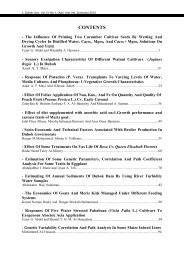You also want an ePaper? Increase the reach of your titles
YUMPU automatically turns print PDFs into web optimized ePapers that Google loves.
J. Duhok Univ., Vol. 14, No.1 (Pure and Eng. Sciences), Pp 1-8, 2011<br />
particularly emphasized, in our case, by the<br />
actual situation of a territory involved in<br />
considerable globalization processes. In this<br />
perspective the planning process cannot exhaust<br />
itself in the attempt to coordinate the<br />
municipalities institutional action, since an<br />
authentic cooperation must base itself on the<br />
self-government of the local realities and thus on<br />
the social actors’ permanent agreeement.<br />
This implies the attempt to let grow the<br />
territorial sujectivity in view of the exploitation<br />
of the local systems and of the territorial<br />
identity.<br />
For this aim it is necessary that the<br />
affirmation of the collective subjectivities, which<br />
has somehow already expressed itself with the<br />
adhesion of a pluraility of actors, institutional or<br />
not, might turn into a shared projectual<br />
engagement which can express its selforganizing<br />
capacity with actions proposal which<br />
have to respond to the local expectations and<br />
interests.<br />
The indication to articulate the plan process<br />
strenghtening the local decision systems goes<br />
towards the direction in which the local<br />
initiatives have the aim to strenghten the<br />
autonomous capacity of a specific area to look<br />
for its own development system. In specific, the<br />
plan indications identified as follows:<br />
a- It supplies specific knowlegde because it<br />
thematizes and visualizes facts and problems at<br />
systemic aggregation level which often slips<br />
away from the attention of the aforesaid<br />
interlocutors;<br />
b- It suggests to their problems possible<br />
alternative solutions, solutions which just derive<br />
from the capacity to see and to think the territory<br />
on a different scale and in any case more<br />
complex, to point out the problems in terms not<br />
purely quantitative, to seize the possible<br />
synergies with other subjects’ action, etc etc.<br />
In such a way it is built an environment<br />
favourable to the development starting from<br />
each territory’s peculiarities and wealths, in the<br />
global competition age are evidenced the<br />
advantages of territorial guideline which,<br />
engaging the typical resources aims at the<br />
quality and difference of the offer of products<br />
and services.<br />
Notes<br />
1. The territorial plan, meant as scientific<br />
definition moment, neutral, ofan ideal territory<br />
organization within a clear and firm context for<br />
the distribution of the administrative, financial<br />
and political resources amongst the various<br />
government’s levels, formulates ideal<br />
hypotheses from the point of view of the whole<br />
rationality of the territory’s use. Therefore “no”<br />
to the homologation, but research and promotion<br />
of integration chances based on the exploitation<br />
of a territory’s differences.<br />
2. It must be rather thought in local systems net<br />
terms (Magnani A. 2000, Ratti R. 1997) which,<br />
coordinating and netting by themselves, create<br />
synergies, that is to say they increase the whole<br />
wealth, not only economical but also social and<br />
cultural, at disposal of an area that is subject to<br />
this insitutional competence of the Region.<br />
According to Dematteis (1995,46) the local<br />
development is always the combination of<br />
something which is fixed with something which<br />
is mobile: the potential specific resources of a<br />
territory with the overlocal nets.<br />
This gives space, anyway, on the territory, to<br />
various development relations, that is to say to<br />
different types of combinations between global<br />
nets, local nets and territory’s resources. There<br />
are architectures which have a major<br />
endogenous component, thus a more or less<br />
strong local identity is noticed (identity meant as<br />
selforganizing capacity, that is to say as specific<br />
principles of local organization). Ther are those<br />
which, instead, strongly depend from<br />
organizations, from overlocal nets.<br />
3. The local identity is meant as a resource, from<br />
the economic point of view, as the territory’s<br />
competitive advantage, from the social and<br />
political point of view (that is to say the<br />
autonomy of the “local”) and from the cultural<br />
point of view, as cultural variety, of a specific<br />
territory (Poli D. 1998, Magnaghi A. 2005 .<br />
4. In a globalization and growing competition<br />
age to promote the sustainability means before<br />
all to strenghten local identities and peculiarities<br />
(Rullani E.1994), indispensable values to be able<br />
to place oneself on the market offering products<br />
improbably subject to world competition. To<br />
build “local systems” is indispensable to<br />
compete with continuity against the economic<br />
trends’s changes.<br />
5. The necessity of a cooperative approach to the<br />
territory’s managemnent and planning is<br />
particularly emphasized by the actual situation<br />
of a territory involved in important globalization<br />
processes (Dematteis G. 1995) .<br />
6. Quoted in Dematteis (1997), these are public<br />
and private local subjects’ self-governing forms.<br />
These local self-governing forms are those who<br />
allows the mobilization od endogenous<br />
7



